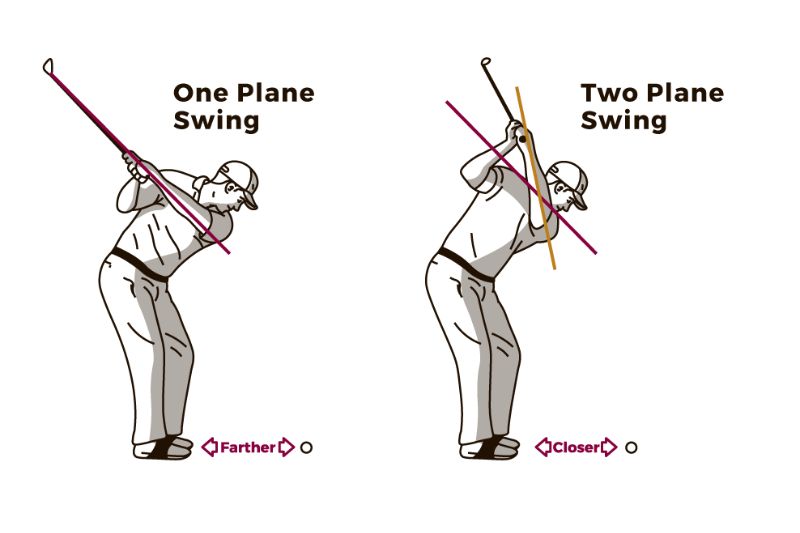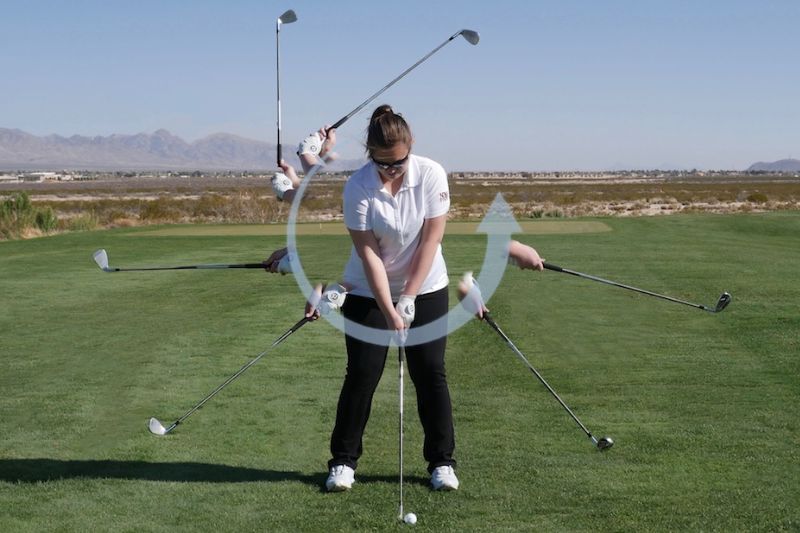Golf is a sport deeply rooted in tradition, and it demands precision and finesse from its players. For many, the pursuit of that perfect shot can often feel elusive. However, mastering the art of swinging a golf club doesn’t have to be an overwhelming challenge. Whether you’re an experienced player or just stepping onto the green for the first time, understanding the fundamentals of the golf swing can significantly elevate your performance on the course. This comprehensive guide not only breaks down the intricacies of the swing into manageable segments but also equips you with valuable insights that apply to golfers of all skill levels. From your initial setup to the all-important follow-through, let’s embark on this journey to transform your swing into a powerful element of your game.
Understanding the Fundamentals of the Golf Swing

At its essence, the golf swing is a fluid and sequential movement comprised of numerous interconnected actions. It’s important to recognize that success in golf isn’t merely about strength; rather, it’s about harnessing your body’s natural motions to generate both power and accuracy. Think of your swing as a sophisticated orchestration of movements, where every aspect—from grip to finish—plays a vital role in creating a harmonious and effective shot. A well-executed swing should feel balanced and controlled, delivering the ball towards your target with consistency.
The Mechanics of the Swing
Understanding the mechanics of a golf swing is crucial for golfers at any level. Each phase of the swing contributes to the outcome, and recognizing how they interlink can enhance your overall performance.
The swing begins with the grip, which serves as the foundation for control over the club. Following the grip is the stance, which prepares your body for balance and power. As you progress through the takeaway, backswing, downswing, impact, and follow-through, each step requires attention to detail and synchronization of body movements.
A strong grasp of these mechanics allows you to troubleshoot problems that may arise during play. By honing each component of the swing, you can develop a consistent technique that translates into better scoring and enjoyment of the game.
The Importance of Rhythm and Tempo
Beyond the technical aspects of the swing, rhythm and tempo are integral components that can influence your performance. Many skilled golfers emphasize the importance of maintaining a smooth and rhythmic swing. This involves finding a comfortable pace that feels natural rather than rushed.
An effective way to measure your rhythm is through practice. Engage in slow-motion swings and gradually increase your speed while keeping the same fluidity. By incorporating this approach into your training regimen, you’ll cultivate a more rhythmical swing that enhances accuracy and distance.
The Grip: Setting the Stage for Success

The grip is often referred to as the “silent partner” in your golf swing. It forms the essential connection between your hands and the club, influencing your control over every shot. Choosing the correct grip is paramount for establishing a solid foundation.
Types of Grips
There are three primary types of grips that golfers typically use: overlapping, interlocking, and baseball grips.
The overlapping grip remains the most popular among professionals. In this grip, the pinky finger of your top hand overlaps the index finger of your bottom hand, promoting a neutral position that balances power and control.
The interlocking grip features the pinky finger of the top hand interlocking with the index finger of the bottom hand. While this grip can offer additional strength, it may lead to an open clubface if not managed properly.
The baseball grip, though less common, utilizes a grip similar to that of holding a baseball bat. This style can foster a stronger grip and help generate power, particularly beneficial for beginners.
Key Considerations for an Effective Grip
When establishing your grip, several factors warrant consideration:
Pressure: Avoid clenching the club too tightly, as this can lead to tension and restrict your swing’s fluidity. Aim for a relaxed yet firm hold that allows freedom of movement.
Hand Position: Your grip should feel comfortable and aligned with your stance. Ensure the club isn’t positioned too far left or right, as this can adversely affect your shot trajectory.
Thumb Alignment: Proper thumb placement is essential. Your thumbs should point roughly down the shaft of the club, contributing to a neutral grip that facilitates better shot direction.
The Stance: Building a Solid Base
Your stance lays the groundwork for a successful swing, providing the necessary balance and power needed to execute a great shot. Finding the appropriate stance is akin to a dancer perfecting their form before performing on stage.
Establishing a Proper Stance
To create a proper stance, begin by positioning your feet shoulder-width apart. This width helps establish a solid base parallel to the target line.
Next, focus on your weight distribution. Shift your weight slightly toward your heels, adopting a posture that feels both neutral and stable. Bending your knees slightly will provide flexibility while maintaining a strong foundation.
Maintaining straight posture throughout your back ensures that your body remains aligned. Avoid slouching or hunching, as this disrupts balance and can hinder your swing.
Head Position and Balance
One critical aspect of your stance is head position. Keeping your head still throughout the entire swing is vital for maintaining focus on the ball. Resist the urge to lift your head prematurely, as this could throw off your balance and accuracy.
Another essential element of a strong stance is ensuring that your weight is evenly distributed. Maintaining a steady center of gravity is crucial for executing a successful swing. Swaying or unnecessary shifting can lead to erratic shots and decreased consistency.
The Takeaway: Initiating the Swing

The takeaway serves as the initial movement in your swing, lifting the clubhead away from the ball and setting the tone for the rest of the motion. Proper execution of this phase is fundamental to achieving an effective swing.
Key Takeaway Techniques
Begin your takeaway with smooth, controlled movements. Sudden jerks or forceful actions can disrupt the flow and affect your swing path. Instead, focus on a gentle lifting motion that preserves the original grip.
As you initiate the takeaway, visualize a smooth, curved path, allowing the clubhead to rise gracefully while remaining square to the target line. This approach not only eases the transition into the backswing but also sets up a cleaner strike.
Body rotation plays a minimal role at the start of the takeaway, as the emphasis lies on achieving controlled movements. Engaging your core muscles will come later in the swing, so prioritize fluidity during this early stage.
Maintaining Consistency
Consistency in the takeaway is paramount for golfers seeking to improve their swing. With practice, you’ll find that a synchronized takeaway becomes almost second nature. Focus on integrating this initial movement into your routine, and experiment with different techniques until you find the one that feels most comfortable.
By refining your takeaway, you’ll set yourself up for success in the subsequent stages of the swing. Remember, a strong foundation leads to a powerful and accurate shot.
The Backswing: Unleashing Power
The backswing is where momentum builds, allowing you to generate the necessary power for an effective strike. This phase blends athleticism with coordination, enabling you to transfer energy seamlessly from your lower body to the clubhead.
Mastering the Backswing
Engaging your core is essential during the backswing. Rotate your body by turning your shoulders and hips away from the target line. This rotational movement creates torque, storing energy that will be released during the downswing.
As you rotate, remember to shift your weight onto your back foot. This movement not only helps stabilize your posture but also enables you to maintain a powerful base. Balancing your weight effectively is key to preventing swaying and enhancing your overall swing mechanics.
Preserving the angle of the clubface while executing the backswing is equally important. Ensure that the clubface remains square to the target line throughout this phase, maximizing potential for clean impact. Aim to bring the clubhead back high, as a wide backswing allows for greater clubhead speed.
Finding Your Balance
Maintaining balance is critical throughout the backswing. Avoid excessive swaying or shifting, as this can impede your ability to execute a powerful strike. Instead, focus on a stable, controlled rotation that promotes a fluid transition into the downswing.
Practice is essential for honing your backswing technique. Utilize drills that reinforce proper body mechanics and weight transfer. Experiment with different speeds and angles to discover what works best for your unique swing.
The Downswing: Transferring Energy
The downswing is where things get exciting—the moment when stored energy bursts forth, transforming the momentum from your backswing into a powerful strike. This phase requires a coordinated movement that efficiently transfers energy from your body to the clubhead.
Key Downswing Techniques
The initiation of the downswing begins with a shift of weight back onto your front foot. This movement serves as the catalyst for generating power, leading to a dynamic and impactful swing.
Focus on a powerful hip turn as the first action in your downswing. This motion should be followed by a smooth rotation of your shoulders, preserving the rhythm established earlier. Keeping your eye on the ball is crucial during this transition phase, as it allows you to maintain focus and control.
It’s important to lower the clubhead in a smooth arc as you approach the ball. Avoid sudden stops or pauses in your movement, as maintaining flow is essential for maximizing power and achieving a clean hit.
Emphasizing Momentum
The key to a successful downswing lies in preserving momentum. As you complete your movement, ensure that you don’t decelerate before impact. Allow the energy built throughout your backswing to carry through, resulting in a confident and powerful strike.
Incorporate drills that emphasize timing and rhythm into your practice sessions. Focus on creating a seamless transition between the backswing and downswing, reinforcing the notion that each phase builds upon the last.
Impact: The Crucial Moment
Impact represents the climax of your swing—the moment when your clubhead meets the ball. It is the culmination of meticulous preparation and precise execution, resulting in the desired shot.
Impact Essentials
During impact, the clubhead should follow a downward path as it strikes the ball. This downward angle ensures a clean and consistent hit, maximizing both accuracy and distance.
At the moment of impact, the clubface must remain square to the target line. An aligned clubface is critical for achieving straight shots; small deviations can lead to unwanted hooks or slices.
As you make contact with the ball, ensure that you’ve completed the weight transfer from your back foot to your front foot. This movement reinforces balance and stability, allowing for a more controlled impact position.
Maintaining Focus
Concentration during impact is paramount. Avoid distractions and stay mentally engaged as you execute the shot. Visualize success and remain mindful of your posture and alignment.
Additionally, consider practicing impact drills that isolate this critical moment in your swing. By focusing solely on the impact phase, you can reinforce positive habits and gain confidence in your ability to strike the ball effectively.
The Follow-Through: A Graceful Finish
The follow-through is often overlooked, yet it plays a significant role in completing the swing. It serves as an extension of your movements, ensuring balance and stability while reinforcing a smooth and controlled motion.
Guiding Principles for the Follow-Through
To execute a proper follow-through, aim to achieve complete rotation. Your body should continue moving forward, with your hips facing the target as you finish the swing. This open position signifies a successful transfer of energy and demonstrates the effectiveness of your technique.
Allow the clubhead to continue its trajectory through the swing, creating a graceful arc. A well-executed follow-through signals mastery of the swing, showcasing the culmination of effort invested in the preceding phases.
Maintaining stability throughout the follow-through is essential. Avoid swaying excessively or losing balance, as this can detract from the quality of your shot. Strive for a relaxed finish, where your weight is predominantly on your front foot and your shoulders face the target.
Achieving Balance
Aim for a balanced and composed finish. Your stance should reflect the confidence you cultivated throughout the swing. As you conclude, take a moment to assess your posture and alignment, reinforcing the importance of ongoing self-evaluation.
Practice follow-through drills to strengthen this aspect of your swing. Focus on achieving a relaxed finish and maintaining stability, as these qualities will contribute to a more polished and consistent overall performance.
Fine-Tuning: Mastering the Basics
Once you have a solid understanding of the fundamental techniques, it’s time to fine-tune your swing. Identifying specific challenges can elevate your game and enhance your overall experience on the course.
Common Swing Problems and Solutions
Slicing is a frequent issue for many golfers, particularly those new to the game. A slice occurs when the ball curves to the right for right-handed players, typically due to an open clubface at impact. To remedy this, pay close attention to your grip and focus on keeping the clubface square to the target line.
Conversely, hooking can happen when the ball curves left for right-handed players. This often results from a closed clubface at impact. To counteract this, ensure you’re not over-rotating your wrists during the backswing, and maintain the clubface’s alignment.
Shanking is another common mishap where contact occurs off the hosel, producing unpredictable shots. This typically arises from misalignment in the swing path. Address this by practicing a consistent swing plane and prioritizing contact with the center of the clubface.
Topping the ball can occur when the club strikes the top of the ball, yielding weak shots. This may stem from a swing path that’s too high or insufficient downward pressure at impact. To correct this, focus on lowering your swing plane and maintaining a descending blow on the ball.
Seeking Professional Guidance
If you’re struggling to overcome certain challenges, consider enlisting the help of a golf instructor. Professional guidance can provide personalized feedback, helping you refine your swing based on your individual needs.
Dedicate time to practice various aspects of your swing regularly. Repetition and consistency will ingrained positive habits that contribute to lasting improvement.
Practice and Repetition: The Path to Consistency
Achieving a masterful golf swing requires commitment to practice and repetition. Just as musicians dedicate hours to honing their craft, golfers must invest time in refining their technique.
Effective Practice Methods
Visiting the driving range regularly is essential for repetition. Focus on specific elements of your swing during each session, such as grip adjustments, stance variations, or refining your swing plane. Structured practice will yield notable progress over time.
Equally important is dedicating time to short game practices. Improving your chipping, putting, and sand play will enhance your overall performance, ensuring a well-rounded game that goes beyond long drives.
Consider utilizing video analysis to assess your swing. Recording yourself in action can reveal flaws in your technique that may go unnoticed otherwise. Reviewing footage allows you to identify areas for improvement and track your progress over time.
Lastly, don’t hesitate to seek professional instruction. A skilled instructor can provide individualized feedback tailored to your unique strengths and weaknesses, accelerating your learning curve.
Conclusion
Mastering the golf swing is a continuous journey—a process of learning, adaptation, and refinement. While this guide has provided a solid foundation, the journey is uniquely yours. Remain open to experimenting with various techniques, and embrace the learning process as you strive to uncover what resonates with your swing. Remember, golf is a game defined by patience and resilience, and with dedication, you’ll find yourself on the path to becoming a more proficient golfer, ready to tackle the challenges of the course with confidence and skill.

I am the owner of Ricks Golf Shop, a popular destination for golf enthusiasts. My passion for golf began in my teenage years and has only grown over the years. With over 10 years of experience in the golf industry, I offer expert advice and quality products. With a friendly demeanor and extensive knowledge, I ensure every customer leaves happy.
